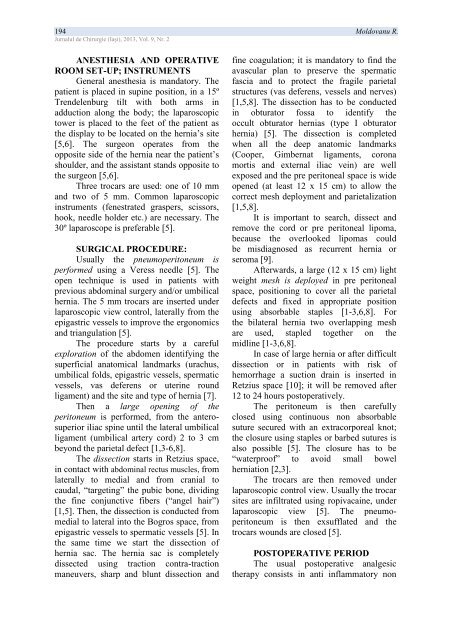PDF (5 MB) - Jurnalul de Chirurgie
PDF (5 MB) - Jurnalul de Chirurgie
PDF (5 MB) - Jurnalul de Chirurgie
You also want an ePaper? Increase the reach of your titles
YUMPU automatically turns print PDFs into web optimized ePapers that Google loves.
194 Moldovanu R.<strong>Jurnalul</strong> <strong>de</strong> <strong>Chirurgie</strong> (Iaşi), 2013, Vol. 9, Nr. 2ANESTHESIA AND OPERATIVEROOM SET-UP; INSTRUMENTSGeneral anesthesia is mandatory. Thepatient is placed in supine position, in a 15ºTren<strong>de</strong>lenburg tilt with both arms inadduction along the body; the laparoscopictower is placed to the feet of the patient asthe display to be located on the hernia’s site[5,6]. The surgeon operates from theopposite si<strong>de</strong> of the hernia near the patient’sshoul<strong>de</strong>r, and the assistant stands opposite tothe surgeon [5,6].Three trocars are used: one of 10 mmand two of 5 mm. Common laparoscopicinstruments (fenestrated graspers, scissors,hook, needle hol<strong>de</strong>r etc.) are necessary. The30º laparoscope is preferable [5].SURGICAL PROCEDURE:Usually the pneumoperitoneum isperformed using a Veress needle [5]. Theopen technique is used in patients withprevious abdominal surgery and/or umbilicalhernia. The 5 mm trocars are inserted un<strong>de</strong>rlaparoscopic view control, laterally from theepigastric vessels to improve the ergonomicsand triangulation [5].The procedure starts by a carefulexploration of the abdomen i<strong>de</strong>ntifying thesuperficial anatomical landmarks (urachus,umbilical folds, epigastric vessels, spermaticvessels, vas <strong>de</strong>ferens or uterine roundligament) and the site and type of hernia [7].Then a large opening of theperitoneum is performed, from the anterosuperioriliac spine until the lateral umbilicalligament (umbilical artery cord) 2 to 3 cmbeyond the parietal <strong>de</strong>fect [1,3-6,8].The dissection starts in Retzius space,in contact with abdominal rectus muscles, fromlaterally to medial and from cranial tocaudal, “targeting” the pubic bone, dividingthe fine conjunctive fibers (“angel hair”)[1,5]. Then, the dissection is conducted frommedial to lateral into the Bogros space, fromepigastric vessels to spermatic vessels [5]. Inthe same time we start the dissection ofhernia sac. The hernia sac is completelydissected using traction contra-tractionmaneuvers, sharp and blunt dissection andfine coagulation; it is mandatory to find theavascular plan to preserve the spermaticfascia and to protect the fragile parietalstructures (vas <strong>de</strong>ferens, vessels and nerves)[1,5,8]. The dissection has to be conductedin obturator fossa to i<strong>de</strong>ntify theoccult obturator hernias (type I obturatorhernia) [5]. The dissection is completedwhen all the <strong>de</strong>ep anatomic landmarks(Cooper, Gimbernat ligaments, coronamortis and external iliac vein) are wellexposed and the pre peritoneal space is wi<strong>de</strong>opened (at least 12 x 15 cm) to allow thecorrect mesh <strong>de</strong>ployment and parietalization[1,5,8].It is important to search, dissect andremove the cord or pre peritoneal lipoma,because the overlooked lipomas couldbe misdiagnosed as recurrent hernia orseroma [9].Afterwards, a large (12 x 15 cm) lightweight mesh is <strong>de</strong>ployed in pre peritonealspace, positioning to cover all the parietal<strong>de</strong>fects and fixed in appropriate positionusing absorbable staples [1-3,6,8]. Forthe bilateral hernia two overlapping meshare used, stapled together on themidline [1-3,6,8].In case of large hernia or after difficultdissection or in patients with risk ofhemorrhage a suction drain is inserted inRetzius space [10]; it will be removed after12 to 24 hours postoperatively.The peritoneum is then carefullyclosed using continuous non absorbablesuture secured with an extracorporeal knot;the closure using staples or barbed sutures isalso possible [5]. The closure has to be“waterproof” to avoid small bowelherniation [2,3].The trocars are then removed un<strong>de</strong>rlaparoscopic control view. Usually the trocarsites are infiltrated using ropivacaine, un<strong>de</strong>rlaparoscopic view [5]. The pneumoperitoneumis then exsufflated and thetrocars wounds are closed [5].POSTOPERATIVE PERIODThe usual postoperative analgesictherapy consists in anti inflammatory non
















